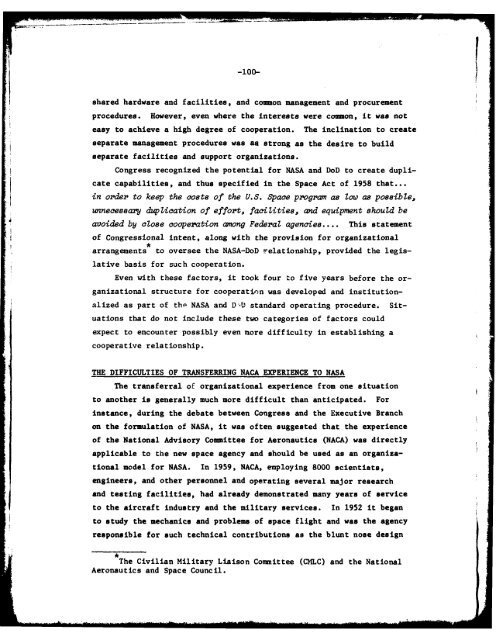A Case Study in NASA-DoD - The Black Vault
A Case Study in NASA-DoD - The Black Vault
A Case Study in NASA-DoD - The Black Vault
You also want an ePaper? Increase the reach of your titles
YUMPU automatically turns print PDFs into web optimized ePapers that Google loves.
-100-<br />
shared hardware and facilities, and common management and procurement<br />
procedures.<br />
However, even where the <strong>in</strong>terests were common, it was not<br />
easy to achieve a high degree of cooperation. <strong>The</strong> <strong>in</strong>cl<strong>in</strong>ation to create<br />
separate management procedures was as strong as the desire to build<br />
separate facilities and support organizations.<br />
Congress recognized the potential for <strong>NASA</strong> and <strong>DoD</strong> to create duplicate<br />
capabilities, and thus specified <strong>in</strong> the Space Act of 1958 that...<br />
<strong>in</strong> order to keep the costs of the U.S. Space program as low as possible,<br />
unnecessary duplication of effort, facilities, and equipment should be<br />
avoided by close cooperation among Federal agencies.... This statement<br />
* of Congressional <strong>in</strong>tent, along with the provision for organizational<br />
arrangements to oversee the <strong>NASA</strong>-<strong>DoD</strong> relationship, provided the legislative<br />
basis for such cooperation.<br />
Even with these factors, it took four to five years before the organizational<br />
structure for cooperation was developed and <strong>in</strong>stitutionalized<br />
as part of the <strong>NASA</strong> and D-.D standard operat<strong>in</strong>g procedure.<br />
Situations<br />
that do not <strong>in</strong>clude these two categories of factors could<br />
expect to encounter possibly even more difficulty <strong>in</strong> establish<strong>in</strong>g a<br />
cooperative relationship.<br />
THE DIFFICULTIES OF TRANSFERRING NACA EXPERIENCE TO <strong>NASA</strong><br />
<strong>The</strong> transferral of organizational experience from one situation<br />
to another is generally much more difficult than anticipated. For<br />
<strong>in</strong>stance, dur<strong>in</strong>g the debate between Congress and the Executive Branch<br />
on the formulation of <strong>NASA</strong>, it was often suggested that the experience<br />
of the National Advisory Committee for Aeronautics (NACA) was directly<br />
applicable to the new space agency and should be used as an organizational<br />
model for <strong>NASA</strong>. In 1959, NACA, employ<strong>in</strong>g 8000 scientists,<br />
eng<strong>in</strong>eers, and other personnel and operat<strong>in</strong>g several major research<br />
and test<strong>in</strong>g facilities, had already demonstrated many years of service<br />
to the aircraft <strong>in</strong>dustry and the military services. In 1952 it began<br />
to study the mechanics and problems of space flight and was the agency<br />
responsible for such technical contributions as the blunt nose design<br />
<strong>The</strong> Civilian Military Liaison Committee (CMLC)<br />
Aeronautics and Space Council.<br />
and the National
















